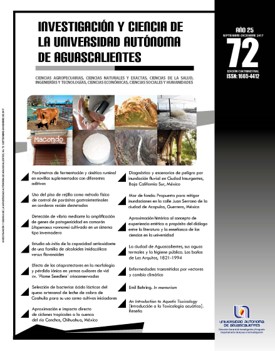Ab initio study of the antioxidant capacity of an imidazole alkaloids versus flavonoids family
DOI:
https://doi.org/10.33064/iycuaa201772219Keywords:
antioxidants, ab initio, alkaloids, flavonoids, Density Functional Theory, global reactivity predictorsAbstract
A Density Functional Theory study of three imidazole alkaloids; Lepidine D, E and F, and three flavonoids; chrysin, quercetin and kaempferol was carried out to obtain information about its antioxidant capacity. The B3LYP/6-31+G(d) method was applied to find the minimum in the potential energy surface and the global reactivity predictors. There was not observed substantial changes in the structural parameters in both families. By the side of reactivity predictors, the Ionization Potential suggests that alkaloids are good antioxidants versus flavonoids, specially the Lepidine F, which present the smallest value of this quantity. An important conclusion in this work is the participation of the imidazole group, suggesting that alkaloids are good antioxidant due to presence of this moiety.
Downloads
References
Aksu, K., Topal, F., Gulcin, I., Tümer, F., & Göksu, F. (2015). Acetylcholinesterase inhibitory and antioxidant activities of novel symmetric sulfamides derived from phenethylamines. Archiv der Pharmazie: Chemistry in Life Sciences, 348(6), 446-455.
Becke, A. D. (1993). Density-functional thermochemistry. III. The role of exact exchange. The Journal of Chemical Physics, 98(7), 5648-5652. doi: 10.1063/1.464913
Ditchfield, R., Hehre, W. J., & Pople, J. A. (1971). Self‐consistent molecular‐orbital methods. IX. An extended gaussian‐type basis for molecular‐orbital studies of organic molecules. The Journal of Chemical Physics, 54(2), 724-728. doi: 10.1063/1.1674902
Fabijanić, I., Brala, C. J., & Pilepić, V. (2015). The DFT local reactivity descriptors of α-tocopherol. Journal of Molecular Modeling, 21(4), 99. doi: 10.1007/s00894-015-2644-y
García–Hernández, E., & Garza, J. (2017). Reactivity sites in dopamine depend on its intramolecular hydrogen bond. Journal of the Mexican Chemical Society, 61(3), 222-228.
Gülcin, I., Büyükokuroglu, M. E., & Küfrevioglu, O. I. (2003). Metal chelating and hydrogen peroxide scavenging effects of melatonin. Journal of Pineal Research, 34(4), 278-281.
Gülcin, I., Büyükokuroglu, M. E., Oktay, M., & Küfrevioglu, O. I. (2003). Antioxidant and analgesic activities of turpentine of Pinus nigra Arn. subsp. pallsiana (Lamb.) Holmboe. Journal of Ethnopharmacolology, 86(1), 51-58.
Halake, K., Birajdar, M., & Lee, J. (2016). Structural implications of polyphenolic antioxidants. Journal of Industrial and Engineering Chemistry, 35, 1-7. doi: 10.1016/j.jiec.2016.01.003
Havsteen, B. H. (2002). The biochemistry and medical significance of the flavonoids. Pharmacology & Therapeutics, 96(2-3), 67-202.
Maier, U. H., Gundlanch, H., & Zenk, M. H. (1998). Seven imidazole alkaloids from Lepidium sativum. Phytochemistry, 49(6), 1791-1795.
Middleton, E., Kandaswami, C., & Theoharides, T. C. (2000). The effects of plant flavonoids on mammalian cells: Implications for inflammation, heart disease, and cancer. Pharmacological Reviews, 52(4), 673-751.
Ortega–Moo, C., Garza, J., & Vargas, R. (2016). The substituent effect on the antioxidant capacity of cathecols and resorcinols. Theoretical Chemistry Accounts, 135, 177-188. doi: 10.1007/s00214-016-1932-7
Parr, R. G., & Yang, W. (1984). Density functional approach to the frontier-electron theory of chemical reactivity. Journal of the American Chemical Society, 106(14), 4049-4050. doi: 10.1021/ja00326a036
Qian, J. Z., Wang, B. C., Fan, Y., Tan, J., & Yang, X. (2015). QSAR study of flavonoid–metal complexes and their anticancer activities. Journal of Structural Chemistry, 56(2), 338-345. doi: 10.1134/S0022476615020195
Sepúlveda-Jiménez, G., Porta-Ducoing, H., & Rocha-Sosa, M. (2003). La participación de los metabolitos secundarios en la defensa de las plantas. Revista Mexicana de Fitopatología, 21(3), 355-363.
Shahidi, F., & Zhong, Y. (2010). Lipid oxidation and improving the oxidative stability. Chemical Society Reviews, 39(11), 4067-4079. doi: 10.1039/b922183m
Srivastava, A., Tandon, P., Ayala, A. P., & Jain, S. (2011). Solid state characterization of an antioxidant alkaloid boldine using vibrational spectroscopy and quantum chemical calculations. Vibrational Spectroscopy, 56(1), 82-88. doi: 10.1016/j.vibspec.2010.08.001
Valiev, M., Bylaska, E. J., Govind, N., Kowalski, K., Straatsma, T. P., Van Dam, H. J. J., …, de Jong, W. A. (2010). NWChem: a comprehensive and scalable open-source solution for large scale molecular simulations. Computer Physics Communications, 181(9), 1477-1489. doi: 10.1016/j.
cpc.2010.04.018
Villuendas–Rey, Y., Alvarez–Idaboy, J. R., & Galano, A. (2015). Assessing the protective activity of a recently discovered phenolic compound against oxidative stress using computational chemistry. Journal of Chemical Information and Modeling, 55(12), 2552-2561. doi: 10.1021/acs.jcim.5b00513
Zou, L., & Akoh, C. C. (2015). Antioxidant activities of annatto and palm tocotrienol-rich fractions in fish oil and structured lipid-based infant formula emulsion. Food Chemistry, 168, 504-511. doi: 10.1016/j.foodchem.2014.07.098
Downloads
Published
How to Cite
License
Las obras publicadas en versión electrónica de la revista están bajo la licencia Creative Commons Atribución-NoComercial-CompartirIgual 4.0 Internacional (CC BY-NC-SA 4.0)









